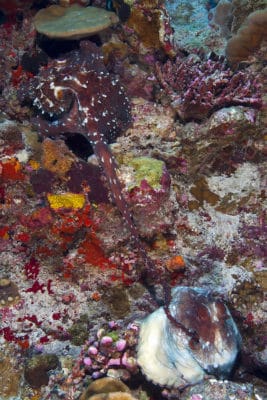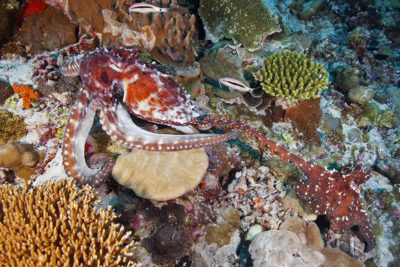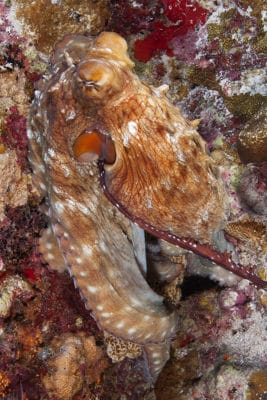Expedition Log: BIOT – Day 11
It wasn’t long after we started our surveys of the Chagos Archipelago that we noticed that the Day Octopus (Octopus cyanea) was quite common here. Usually an intelligent creature like an octopus is enough of a draw to pull us away from our work for a moment or two as we try to get a closer look or even a decent photograph. They were so frequent here that I saw at least one of them each day during our three survey dives—and sometimes several of them on a single dive. Most of the ones we saw though were tucked down in their burrows or hiding in a small crevice in the reef. They revealed little more than a large pair of intelligent eyes staring back at the odd creatures who had invaded their world this day, carrying PVC survey gear, underwater writing slates and cameras and bubbling noisily.
While doing my coral photo transects at 15 meters depth on one of our survey dives, I noticed some of the other scientists intently studying something a little ways down in the direction I was working toward. I noted the area and figured I’d check it out once I had completed my transect. When one of the scientists came over with a note written on their slate stating that there was an octopus photo op, I decided to suspend my normal photographic work and reset my camera and underwater strobes to see if I could capture a good image of these locally common but timid cephalopods.
Nothing could have prepared me for the little bit of good fortune I was about to receive. There was not one octopus but two and they were not hiding deep in a crevice but out and about on the reef. With their incredible camouflage it took me a moment to realize what was going on—these octopuses were mating! Octopus reproduction involves the male using a specially modified arm called a hectocotylus to transfer a spermatophore packet into the female’s mantle cavity. I remembered that the hectocotylus was the third arm (from the front) on the right side and indeed this arm, greatly thinned and extended, spanned the distance between the two and terminated somewhere within the mantle opening on the left side of the female. This was something I had read about and likely have seen on at least one nature show but now the show was real and I was witness to the next generation of octopuses in the making.

The male (at top) extends his hectocotylus into the female’s mantle to transfer a spermatophore.
I positioned myself trying to capture this event in a photo but not wanting to disturb the pair. It soon became evident that the normally shy octopuses didn’t seem to even register that I was there. I was able to take a few quick grab shots in case the moment only lasted seconds. But they were in no hurry and I was able to recompose the photo and rearrange my strobes to try to make these masters of camouflage stand out among the corals and sponges on the bottom. After several photos I thought I had adequately captured the moment and returned to finish the coral transect I was still in the middle of photographing.
When I got to the end of my transect I was once again near the mating couple. I looked over to see them still connected at arm’s length but just then the female took off and bolted for the depths. I watched as she headed-off down the slope till the reef gave way to a sandy plain at around 35 meters depth. The male was in hot pursuit the entire way till, by chance, he passed over a second female down at about 30 meters. She popped up out of an unseen hiding spot and started heading back up the slope. The male instantly reversed course and started pursuing this second female. They worked their way back up the reef slope to 15 meters depth where I was watching from and came to rest not far from me. Once again the male extended his hectocotylus arm toward the female and, attached in this way, she led him even shallower toward where the reef flattened out at 10 meters depth. Like before I was able to photograph this new pairing with little notice from my subjects who seemed oblivious. When they reached the top of the slope they were near some of the other scientists who were doing benthic and coral transect surveys. Some shouting and grunting through my regulator caught their attention and they were also able to witness this rarely seen behavior.

The second female leads her suitor back up the reef slope.

The hectocotylus can be seen entering the mantle through the aperture near the funnel.
Here’s a short video of the male unrolling his hectocotylus toward the female…
Source video: Kristin Stolberg
Video editing: Stefan Andrews
Photos by Ken Marks.